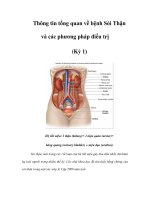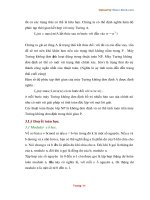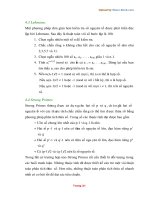Bảo mật thông tin: Các phương pháp mã hóa - phần 1 pot
Bạn đang xem bản rút gọn của tài liệu. Xem và tải ngay bản đầy đủ của tài liệu tại đây (2.12 MB, 67 trang )
McGraw-Hill
©
The McGraw-Hill Companies, Inc., 2000
Bo mt h thng thông tin
CC PHƯƠNG PHP M HA
PHN 1
1/2011
3.2
❏ To define the terms and the concepts of symmetric
key ciphers
❏ To emphasize the two categories of traditional
ciphers: substitution and transposition ciphers
❏ To describe the categories of cryptanalysis used to
break the symmetric ciphers
❏ To introduce the concepts of the stream ciphers and
block ciphers
❏ To discuss some very dominant ciphers used in the
past, such as the Enigma machine
Objectives
Chapter 3
3.3
3-1 INTRODUCTION
3-1 INTRODUCTION
Figure 3.1 shows the general idea behind a symmetric-key
Figure 3.1 shows the general idea behind a symmetric-key
cipher. The original message from Alice to Bob is called
cipher. The original message from Alice to Bob is called
plaintext; the message that is sent through the channel is
plaintext; the message that is sent through the channel is
called the ciphertext. To create the ciphertext from the
called the ciphertext. To create the ciphertext from the
plaintext, Alice uses an encryption algorithm and a shared
plaintext, Alice uses an encryption algorithm and a shared
secret key. To create the plaintext from ciphertext, Bob
secret key. To create the plaintext from ciphertext, Bob
uses a decryption algorithm and the same secret key.
uses a decryption algorithm and the same secret key.
3.1.1 Kerckhoff’s Principle
3.1.2 Cryptanalysis
3.1.3 Categories of Traditional Ciphers
Topics discussed in this section:
Topics discussed in this section:
3.4
Figure 3.1 General idea of symmetric-key cipher
3.1 Continued
3.5
3.1 Continued
If P is the plaintext, C is the ciphertext, and K is the key,
If P is the plaintext, C is the ciphertext, and K is the key,
We assume that Bob creates
We assume that Bob creates
P
P
1
1
;
;
we prove that
we prove that
P
P
1
1
= P
= P
:
:
3.6
Figure 3.2 Locking and unlocking with the same key
3.1 Continued
3.7
3.1.1 Kerckhoff’s Principle
Based on Kerckhoff’s principle, one should always
assume that the adversary, Eve, knows the
encryption/decryption algorithm. The resistance of the
cipher to attack must be based only on the secrecy of the
key.
3.8
3.1.2 Cryptanalysis
As cryptography is the science and art of creating secret
codes, cryptanalysis is the science and art of breaking
those codes.
Figure 3.3 Cryptanalysis attacks
3.9
3.1.2 Continued
Figure 3.4 Ciphertext-only attack
Ciphertext-Only Attack
3.10
3.1.2 Continued
Figure 3.5 Known-plaintext attack
Known-Plaintext Attack
3.11
3.1.2 Continued
Figure 3.6 Chosen-plaintext attack
Chosen-Plaintext Attack
3.12
3.1.2 Continued
Figure 3.7 Chosen-ciphertext attack
Chosen-Ciphertext Attack
3.13
3-2 SUBSTITUTION CIPHERS
3-2 SUBSTITUTION CIPHERS
A substitution cipher replaces one symbol with another.
A substitution cipher replaces one symbol with another.
Substitution ciphers can be categorized as either
Substitution ciphers can be categorized as either
monoalphabetic ciphers or polyalphabetic ciphers.
monoalphabetic ciphers or polyalphabetic ciphers.
3.2.1 Monoalphabetic Ciphres
3.2.2 Polyalphabetic Ciphers
Topics discussed in this section:
Topics discussed in this section:
A substitution cipher replaces one
symbol with another.
Note
3.14
3.2.1 Monoalphabetic Ciphers
In monoalphabetic substitution, the
relationship between a symbol in the
plaintext to a symbol in the ciphertext is
always one-to-one.
Note
3.15
3.2.1 Continued
The following shows a plaintext and its corresponding ciphertext.
The cipher is probably monoalphabetic because both l’s (els) are
encrypted as O’s.
Example 3.1
The following shows a plaintext and its corresponding ciphertext.
The cipher is not monoalphabetic because each l (el) is encrypted
by a different character.
Example 3.2
3.16
3.2.1 Continued
The simplest monoalphabetic cipher is the additive cipher. This
cipher is sometimes called a shift cipher and sometimes a Caesar
cipher, but the term additive cipher better reveals its
mathematical nature.
Additive Cipher
Figure 3.8 Plaintext and ciphertext in Z
26
3.17
Figure 3.9 Additive cipher
3.2.1 Continued
When the cipher is additive, the
plaintext, ciphertext, and key are
integers in Z
26
.
Note
3.18
3.2.1 Continued
Use the additive cipher with key = 15 to encrypt the message
“hello”.
Example 3.3
We apply the encryption algorithm to the plaintext, character by
character:
Solution
Solution
3.19
3.2.1 Continued
Use the additive cipher with key = 15 to decrypt the message
“WTAAD”.
Example 3.4
We apply the decryption algorithm to the plaintext character by
character:
Solution
Solution
3.20
3.2.1 Continued
Historically, additive ciphers are called shift ciphers. Julius
Caesar used an additive cipher to communicate with his officers.
For this reason, additive ciphers are sometimes referred to as the
Caesar cipher. Caesar used a key of 3 for his communications.
Shift Cipher and Caesar Cipher
Additive ciphers are sometimes referred
to as shift ciphers or Caesar cipher.
Note
3.21
3.2.1 Continued
Eve has intercepted the ciphertext “UVACLYFZLJBYL”. Show
how she can use a brute-force attack to break the cipher.
Example 3.5
Eve tries keys from 1 to 7. With a key of 7, the plaintext is “not
very secure”, which makes sense.
Solution
Solution
3.22
3.2.1 Continued
Table 3.1 Frequency of characters in English
Table 3.2 Frequency of diagrams and trigrams
3.23
3.2.1 Continued
Eve has intercepted the following ciphertext. Using a statistical
attack, find the plaintext.
Example 3.6
When Eve tabulates the frequency of letters in this ciphertext, she
gets: I =14, V =13, S =12, and so on. The most common character
is I with 14 occurrences. This means key = 4.
Solution
Solution
3.24
3.2.1 Continued
Multiplicative Ciphers
In a multiplicative cipher, the plaintext
and ciphertext are integers in Z
26
; the
key is an integer in Z
26
*.
Note
Figure 3.10 Multiplicative cipher
3.25
3.2.1 Continued
What is the key domain for any multiplicative cipher?
Example 3.7
The key needs to be in Z
26
*. This set has only 12 members: 1, 3, 5,
7, 9, 11, 15, 17, 19, 21, 23, 25.
Solution
Solution
We use a multiplicative cipher to encrypt the message “hello” with
a key of 7. The ciphertext is “XCZZU”.
Example 3.8









